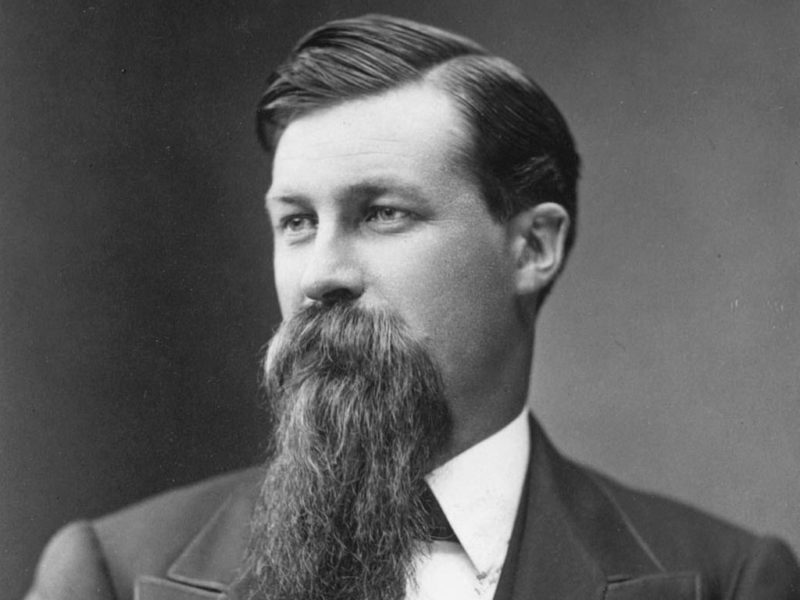Geologist Thomas C. Chamberlin wrote an important paper titled, “The Method of Multiple Working Hypotheses” in 1890.1 Though he discusses the usefulness of using several hypotheses within a scientific field, we can apply this concept to entire paradigms, as well. Completely different worldviews such as biblical creationism and secular naturalism can benefit from each other, regardless of their contrasting philosophies of science. Questions can be brought up that might not have been considered because of one’s particular paradigm, and thus study can become more rigorous and research strengthened by those with an opposing viewpoint. As a result, multiple working paradigms benefit the progress of science.
The views expressed in this article reflect those of the author mentioned, and not necessarily those of New Creation.
Two Fundamental Studies
Thomas C. Chamberlin, late 19th century geologist and founder of the Journal of Geology, wrote a fascinating and important paper regarding the approach to science. In his writing, he supports a pluralistic perspective of answering the “How?” questions. He suggests that it is beneficial for the progress of science to have multiple working hypotheses for any given idea within a paradigm, hence the name of his article.
Chamberlin says that there are “two fundamental studies,” the first of which is primarily acquisition of knowledge and the study of previous accomplishments. Students fall into this category—they are memorizing facts, reading textbooks and articles, etc. The second kind of study has the goal of discovering “new truth.” It involves creative thinking applied to a specific discipline with the hope of finding something new. And while it can include entirely new research never done before, Chamberlin points out that this mode of study can also apply to past material and data, as long as the research is unique and independent.
The Wise Men of Old
In the early development of the sciences, a scientist could be generally familiar with most disciplines with relative ease. Ranging from botany to physics to geology, the scope of knowledge at that time remained quite limited. So, these individuals were often assumed to be “wise men, or aspired to be thought so, all that was known, as a justification of their claims” (pg. 838). As a result, when new discoveries came to light, people often turned to these individuals for their respective explanations. These scientists would then quickly come up with a solution to the problems presented. Consequently, Chamberlin suggests, “too often a theory is promptly born and evidence hunted up to fit in afterward.”2
These scientist proposed general theories, but would not necessarily have a lot of data to back them up—and yet the theories quickly became widely accepted in the scientific community. They are held to, not because they are the most logical, but because they are the longest held. Chamberlin likens it to a blind love and says that “all too often they put under strain the integrity of the intellectual processes.”3 This becomes problematic, of course, as the scientific community becomes complacent and no longer thinks outside the box. Of Chamberlin’s two fundamental types of studies, only the former is actively pursued. The quest to discover new truth is now hindered by this blindness.
Partiality and Bias are Factors
As soon as a proposal proves an adequate solution, the scientific community accepts it and moves on, rarely stopping to consider alternatives. There becomes a tendency towards bias. Partialism quickly dominates and the new theory “then rapidly rises to a position of control in the process of the mind and observation, induction, and interpretation are guided by it.”4 The scientific method, instilled in the minds of young people since their elementary years, now assumes the role as the ultimate method of scientific inquiry.
However, Chamberlin argues that his method of multiple working hypotheses is not just a “proposition to be established,” but instead it is to be “used as a means of determining facts.”5 That is, it should be for the purpose of guiding investigation. Or, as he succinctly puts it, “the hypothesis is a mode rather than an end.”6 When this distinction is made, it becomes less easy to have an attachment to a hypothesis, thus promoting better scientific research since it is no longer a rigid, ruling idea. It is the preferred method, as it “distributes the effort and divides the affections” of scientists.7
New research and ideas, as a result, are more diverse and held to by a variety of people—encouraging the community to work together for many ideas instead of giving too much attention to the favored hypothesis. This increased impartiality ensures that as new ideas come along, scientists do not overlook them. Of course, in some areas of study this may not be practical, Chamberlin concedes, but generally it is a useful method.
Paradigms in the Scientific Community
Chamberlin’s proposal of this method is quite important, and too often overlooked. His article, published in 1890, applies even more so today. Though this paper addresses the importance of having multiple working hypotheses, we can also apply it on a broader scope. In 1962, Thomas Kuhn’s book titled “The Structure of Scientific Revolutions” introduced the idea of paradigm as applied to the scientific community.8

A paradigm, Kuhn proposes, is essentially a worldview through which a community of scientists do research.9 Paradigms change as scientists introduce and embrace new theories. However, the scientific community should not be so hasty in abandoning a particular theory for another. For example, when the theory of plate tectonics was introduced in the 20th century, it became accepted within just a few decades. While this is definitely a positive example of the rapid change in theory, there can also be dangers in the entirety of a scientific community clinging to a singular idea.
It is good to have not only a wide variety of hypotheses and theories, but also entire paradigms. Even if an entire worldview seems outrageous to one side, it is still beneficial to the scientific community as a whole. Like Chamberlin remarks, “the reaction of one hypothesis upon another tends to amplify the recognized scope of each. Every hypothesis is quite sure to call forth into clear recognition new (or neglect) aspects of the phenomena in its own interest.”10 A wide variety of thinking encourages hard questions that help each side hone their own arguments. To return to the ideas of Kuhn, competition between what he terms “research programs”11 encourages the development and progress of science.
Competition Strengthens Paradigms
We can apply these same principles more specifically to the debate between materialistic naturalism and biblical creationism. It can become easy for either position to become dogmatic about their views. They can look down on those who disagree, saying they are stupid or foolish for believing what they believe. For example, George McCready Price, an early Adventist creationist, believed that his specific hypotheses on the Ice Age had to be correct because he upheld Scripture and thus must be right, instead of exploring other mechanisms for dramatic climate change. Conversely, strict Lyell-following uniformitarianists failed to consider the possibility that the Channeled Scablands could form as a result of huge, cataclysmic floods because they limited their thinking to slow, gradual processes.
Leonard Brand and Arthur Chadwick, both influential creationists, wrote a book on “Faith, Reason, and Earth History.”12 They pose the question: can there be an “alternative, nonnaturalistic philosophy [that] could also be successful in guiding the scientific process?”13 (Ch. 5). It is unfortunate that they must even ask this. As long as scientists conduct good research and accurately report their findings, they are doing “good” science. Their philosophy does not inherently inhibit their ability to study the world. (Of course, there are extremists on both ends of the spectrum who are dishonest and not researching well—but we will excluded them from this discussion.) Oftentimes, both sides are attacking each other’s philosophy of science rather than their scientific results and conclusions. Their perspective is narrowed due to their philosophy.
Inviting questions from those of opposing viewpoints will only benefit the progress of science. It will never hinder the search for truth. It, in fact, does the opposite. Good questions, regardless of from where (or whom) they come, can be a catalyst for discovery. We see this throughout history. For example, Thomas Edison and Nicola Tesla had disagreements, with one dismissing the other’s work. However, both made many major contributions and we remember both their names to this day for their inventions. Brand and Chadwick make an excellent point:
Science will reap benefits if we encourage scientists with differing philosophical views to be active in science. Neither has anything to fear from the other as long as both are (1) active in the scientific process and engaged in quality research, (2) honest with the data, and (3) taking an active part in the scientific community, publishing their work, attending meetings and presenting papers, and talking with their peers about their work. No quality control is quite as effective as knowing that when one presents a paper, others—including some who disagree—will be ready to point out the mistakes that may have been overlooked. Also, scientists in each group are likely to recognize some types of data that the other might overlook.14
The review and debate between groups strengthens each other. Because of this, neither side needs to be dogmatic as research and data benefits all parties.
Conclusion
We should apply Chamberlin’s emphasis on the importance of multiple working hypotheses not only to hypotheses and theories, but also to entire scientific paradigms. The same principle applies to people of differing world views, such as biblical creationists and secular naturalists. The cooperation of individuals from varying perspectives and scientific understandings allows for a broader range of questions and viewpoints that can be presented. People in either group can become too attached to their own particular ideas. This could potentially blind them to new discovery.
We should not hinder science because of disagreements in philosophy of science. Instead, we should celebrate different viewpoints for their contributions to the body of scientific research. For this reason, biblical creationism is ultimately beneficial for the progress of science. Regardless if one holds it to be true, biblical creationism furthers scientific progress by its very nature. It proposes different questions that the conventional, mainstream community might not considered.
Footnotes
- T. C. Chamberlin. “The Method of Multiple Working Hypotheses.” The Journal of Geology. 1897, 837–48. ↩︎
- Chamberlin, 1897, 838. (Footnote 1) ↩︎
- Chamberlin, 1897, 840. (Footnote 1) ↩︎
- Chamberlin, 1897, 840. (Footnote 1) ↩︎
- Chamberlin, 1897, 842. (Footnote 1) ↩︎
- Chamberlin, 1897, 842. (Footnote 1) ↩︎
- Chamberlin, 1897, 843. (Footnote 1) ↩︎
- Thomas S. Kuhn The Structure of Scientific Revolutions (International Encyclopedia of Unified Science : Foundations of the Unity of Science ; v. 2, No. 2. University of Chicago Press, 1974). ↩︎
- Kuhn, 1974. (Footnote 8) ↩︎
- Chamberlin, 1897, 846. (Footnote 1) ↩︎
- Kuhn, 1974. (Footnote 8) ↩︎
- Leonard Brand and Arthur Chadwick. Faith, Reason, & Earth History : A Paradigm of Earth and Biological Origins by Intelligent Design (Andrews University Press, 2016). ↩︎
- Brand and Chadwick, 2016, Ch 5. (Footnote 9) ↩︎
- Brand and Chadwick, 2016, Ch 5. (Footnote 9) ↩︎












Amen. It sharpens the wits to look at all options for a solution and creationism was the first and still the best and must be a option. Rejection of it is unscientific.
I am a young earth creationist geologist myself and I have been looking for alternate theories of plate tectonics, particularly the prevailing view in the 1960s before plate tectonics was proposed where the continental plates were believed to be stationary and immovable. Do you remember the Psalm that says the foundation of the earth cannot be moved? (Psalm 104:5-6). I totally reject continental drift theory and I believe that it is pseudoscience (which is what opponents of plate tectonic theory believed when it was proposed). I just think the earth’s tectonic processes include rifting only and no conveyer belt subduction zones. In other words, the continental plates are stationary and only move vertically during rifting. Am I the only one? Dr. Whitmore once recommended me to read the book “The Origin of Mountains”by Ollier and Pain, who are uniformitarians but are critical of plate tectonic theory.
It sounds like you might lean toward more of a Michael Oard type of Flood model (check out this and this). Most creationists, and just about every creation geologist I’m aware of, do agree with plate tectonics, just not the long ages associated with it. That’s why most will hold to Catastrophic Plate Tectonics or some variation of it. It is the most robust of the creationist Flood models and while it does have problems that are still being investigated, it is a good starting point. I have another article about it if you’re interested! In that article, I have a comment going into a bit of detail about plate tectonics as well 🙂
Thank you for reading and taking the time to comment!
Sara Anne